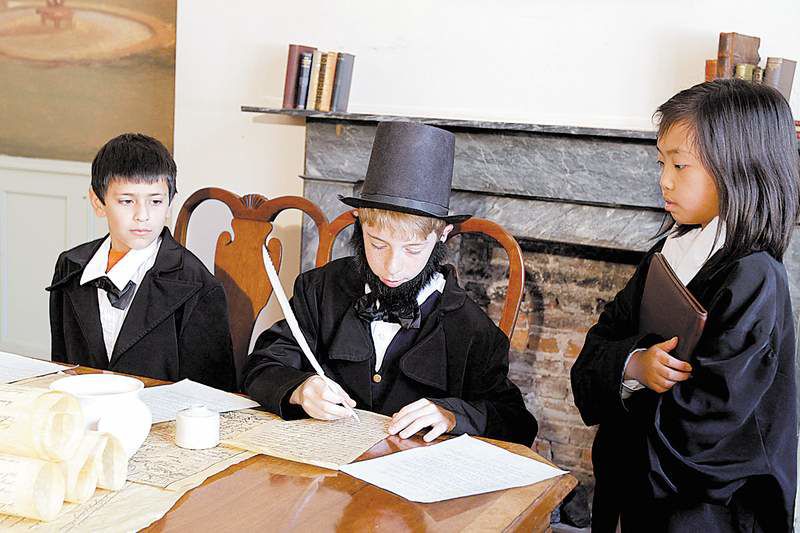The tactics of teaching the Civil War
Published 5:00 am Tuesday, April 12, 2011

- Virginia fourth-graders act out the signing of the Emancipation Proclamation. Fort Sumter, S.C., was attacked 150 years ago today, sparking the Civil War. Even today, teachers and school boards across the nation differ on how to teach the conflict.
WASHINGTON — Take an empty half-pint milk carton. Glue 12 Popsicle sticks onto the sides and hold them in place with a rubber band. Pretend it is a wooden warship.
Now make another, and wrap both vessels in aluminum foil. Float your two “ironclads” in a plastic tub of water. Bombard them with blue marbles. Pretend they are the Monitor and the Merrimack.
“Guess who won this battle?” teacher Cindy Agner asks.
“No one,” the kids chorus.
“This is what they call a draw.”
And this is how the Civil War comes to life for a roomful of suburban fourth-graders, 150 years after the nation’s deadliest armed conflict began. Agner’s reenactment of the landmark naval Battle of Hampton Roads drew her class into a chapter of American history that has long provoked education debate.
The war’s sesquicentennial, starting today with the anniversary of the attack on Fort Sumter in South Carolina, provides a teachable moment for schools everywhere. But how and when students learn about slavery and secession, Ulysses S. Grant and Robert E. Lee, Bull Run (or Manassas) and Appomattox varies enormously from state to state, school to school and even teacher to teacher.
This year, Virginia learned anew the sensitivity of Civil War education when the state Board of Education withdrew approval of a fourth-grade textbook, “Our Virginia: Past and Present,” that asserted thousands of African Americans fought for the South. Most historians reject that claim.
Last year, the Texas State Board of Education voted to require eighth-graders to study the inaugural address of Confederate President Jefferson Davis alongside President Abraham Lincoln’s first and second inaugurals and his Gettysburg Address. That was one of many controversial revisions to Texas standards.
Jeremy Stern, a historian who reviewed state academic standards this year for the Thomas B. Fordham Institute, said differences in the timing and scope of Civil War education nationwide are dramatic. Often, he said, the war is not taught systematically until middle school.
The big question: Why?
For elementary teachers, a central challenge is to explain why the war happened. Edward Ayers, president of the University of Richmond and a historian who has written about the Civil War and the South, recalled one day when his 11-year-old daughter walked into his study with a textbook and asked, “Daddy, what caused the Civil War?”
“I paused a moment,” Ayers said, “calculated the costs and benefits of trying to explain historic complexity to a young person, and said, ‘Slavery, honey.’ “
As Ayers elaborated in an e-mail: “That’s the bedrock of everything else that happened, even though white people at the time, especially in the North, might not have felt it so directly. They would have said they fought to maintain the federal government and the Union. But Americans would not have been arguing about that in the first place without the challenges slavery presented.”
The bottom line for young students, agreed William Davis, a Virginia Tech historian: “Slavery led to secession, and secession led to the war. But even that so oversimplifies it.”
South Carolina, where the war started, asks third-graders to “summarize the institution of slavery prior to the Civil War”; explain the reasons for the state’s secession, “including the abolitionist movement, states’ rights and the desire to defend South Carolina’s way of life”; and outline the course of the war and the state’s role in it.
Arizona asks third-graders to “recognize that there were issues (e.g., slavery, states’ rights, South seceded from the Union) associated with the Civil War.” Maryland calls for fourth-graders to “analyze regional differences in the Civil War” and “explain why loyalties to the North and South were divided” in the state. D.C. schools teach about the Emancipation Proclamation and the end of slavery in the nation’s capital to fifth-graders.
In Virginia, scene of so many crucial battles, schools capitalize on their location to teach fourth-graders about a war that literally split the state.
Agner’s school, Laurel Hill Elementary in Fairfax County, Va., is about 20 miles southeast of the battlefield where a Confederate general named Thomas Jackson earned the nickname “Stonewall” in July 1861.
The school represents an ethnic mosaic that 19th-century Virginians scarcely could have imagined: Sixty languages are spoken in the homes of its students, the most common being Korean, Vietnamese and Spanish.
Through 45-minute lessons over six weeks in February and March, Agner, 31, immersed students in the war that she usually calls the Civil War, though she also tells students it is sometimes called the War Between the States, often identified with pro-Confederate views.
Her students read aloud from the play “Mary Chesnut and her Diary,” dramatizing Virginians’ torn feelings about secession in early 1861. They studied a map with states colored blue for most of the Union, gray for the Confederacy, green for slave states that stayed in the Union and yellow for the Union-loyalist state carved out of the Old Dominion in 1863 — West Virginia.
They learned about the industrializing North and agricultural South, the fallout from Abraham Lincoln’s election in 1860 and Lee’s 1862 victory at Fredericksburg, Va. Their Smart Board flickered with short video clips on key events and maps showing the evolving demographics of the slave population — a group that Virginia history standards ask schools to call “enslaved African Americans.”
One afternoon, during a lesson on the First Battle of Bull Run, Agner sensed her students were getting antsy. She had read to them about civilian spectators whose day turned from picnics to panic, talked about the high toll of dead and wounded, recounted how Southern forces rallied around Jackson when another Confederate commander cried out that he was standing “like a stone wall.” Now she improvised.
“Cavin,” Agner said. “Come and stand and show us what he might have looked like.”
Cavin Loh, 10, popped up, puffed his chest, stuck out his chin, stared sternly ahead.
“Can I blink?” he asked.
“No, you’re a stone wall,” Agner said.
Then she asked others to strike poses. One stood and saluted. Another put her foot on a chair and leaned forward. “I see him on a horse,” Agner said. “I see him ready to shout. I see no fear.”
In March, the class capped its Civil War unit with a field trip to the Decatur House in Washington. Students donned costumes as soldiers and politicians from the period and produced a video about the Emancipation Proclamation.
Dominique Pham, 10, said: “We learned about the two sides and what they liked and what they didn’t like. The Union didn’t like slavery because they thought it’s wrong. I agree with them. And it’s not nice to make people do things they don’t want to do.”






